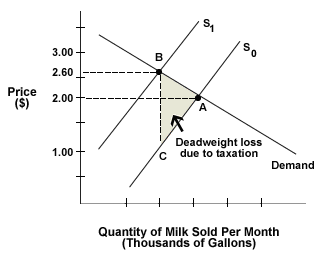Taxes reduce both demand and supply, and drive market equilibrium to a price that is higher than without the tax and a quantity that is lower than without the tax.
Actual and Statutory Incidence of Tax
Tax authorities usually require either the buyer or the seller to be legally responsible for payment of the tax. Tax incidence is the way in which the burden of a tax is shared among the market participants (“who bears the cost?”). Taxes will typically constitute a greater burden for whichever party has a more inelastic curve – e.g., if supply is inelastic and demand is elastic, the burden will be greater on the producers.
Suppose that a state government imposes a tax upon milk producers of $1 per gallon.
Figure 3.7: Incidence of Tax
 |
Figure 3.7 shows the original price for milk was $2 per gallon. After imposition of the tax, the supply curves shift up and to the left. Consumers pay $2.60 per gallon. Sellers receive $1.60 per gallon after paying the tax. So sixty cents of the tax is actually paid by consumers, while forty cents is paid by the milk producers.
The triangle ABC above represents the deadweight loss due to taxation, which occurs because now there are fewer mutually beneficial exchanges between buyers and sellers. Deadweight loss stems from foregone economic activity and is a loss that does not lead to an offsetting gain for other market participants; it is a permanent decrease to consumer and/or producer surplus.
Elasticity of Supply and Demand and the Incidence of Tax
If buyers have many alternatives to a good with a new tax, they will tend to respond to a rise in price by buying other things and will, therefore, not accept a much higher price. If sellers easily can switch to producing other goods, or if they will respond to even a small reduction in payments by going out of business, then they will not accept a much lower price. The incidence of the tax will tend to fall on the side of the market that has the least attractive alternatives and, therefore, has a lower elasticity.
Cigarettes are one example where buyers have relatively few options; we would therefore expect the primary burden of cigarette taxes to fall upon the buyers.
A subsidy shifts either the demand or supply curve to the right, depending upon whether the buyer or seller receives the subsidy. If it is the buyer receiving the subsidy, the demand curve shifts right, leading to an increase in the quantity demanded and the equilibrium price. If the seller receives the subsidy, the supply curve shifts right and the quantity demanded will increase, while the equilibrium price decreases.
A quota limits the amounts of a good that can be produced. If the quota is greater than what would be produced under normal market conditions, then it will have no effect. If the amount is less, than the market equilibrium that is achieved will be at a higher price than what would occur without the quota, as consumers will be willing to pay more.
Making a good or service illegally impacts demand, supply and market equilibrium by imposing a cost (prosecution and punishment) on the buyer or seller (or both) of the good/service. Quantities of illegal goods will always be less than if they were legal, but the impact on price is determined by whether the buyer or seller (or both) is punished. If the only the buyer is penalized, the equilibrium price will be lower; the risk of punishment is regarded by buyers as a cost, and reduces the price they will pay to the seller. If the seller is penalized, the equilibrium price will be higher as the cost of punishment is factored into the seller’s cost. Prices will remain relatively unchanged if the risk and cost of punishment is shared equally.
(See more) Opportunity Costs






0 comments:
Post a Comment